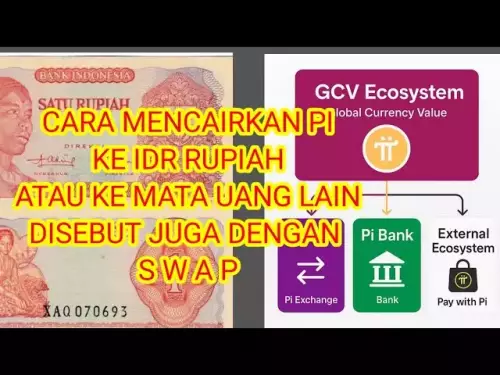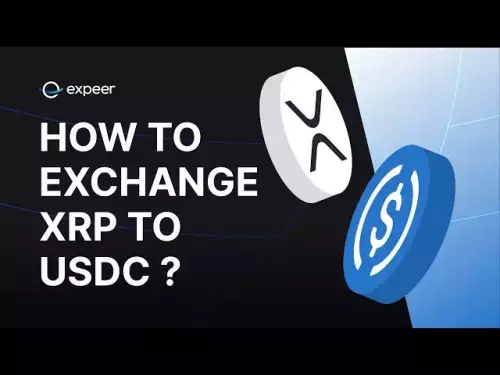-
 bitcoin
bitcoin $112715.707551 USD
-1.71% -
 ethereum
ethereum $4101.475385 USD
-3.01% -
 tether
tether $1.000644 USD
-0.02% -
 bnb
bnb $1207.619465 USD
-6.77% -
 xrp
xrp $2.501451 USD
-3.98% -
 solana
solana $202.947124 USD
-3.32% -
 usd-coin
usd-coin $1.000295 USD
0.04% -
 dogecoin
dogecoin $0.203884 USD
-4.47% -
 tron
tron $0.317154 USD
-1.72% -
 cardano
cardano $0.695009 USD
-4.43% -
 hyperliquid
hyperliquid $38.853961 USD
-8.23% -
 chainlink
chainlink $18.988674 USD
-4.64% -
 ethena-usde
ethena-usde $1.000233 USD
-0.03% -
 stellar
stellar $0.337050 USD
-3.63% -
 bitcoin-cash
bitcoin-cash $536.861728 USD
-1.28%
How to find UNI arbitrage opportunities? How to use cross-platform spreads
To find UNI arbitrage opportunities, monitor price differences across exchanges using tools like bots or APIs, and execute trades quickly to profit from spreads.
Apr 30, 2025 at 02:42 am

Finding UNI arbitrage opportunities involves identifying price differences of the Uniswap (UNI) token across various cryptocurrency exchanges and platforms. Arbitrage is the practice of taking advantage of these price discrepancies to generate profit. To successfully execute UNI arbitrage, you need to be aware of the cross-platform spreads, which are the differences in prices between different platforms. This article will guide you through the process of finding UNI arbitrage opportunities and using cross-platform spreads effectively.
Understanding UNI and Arbitrage
UNI is the governance token of Uniswap, a decentralized exchange (DEX) that operates on the Ethereum blockchain. Arbitrage in the context of UNI involves buying the token on one platform where it is cheaper and selling it on another where it is more expensive. The key to successful arbitrage is speed and efficiency, as price differences can be fleeting.
To start, you need to understand the basics of how arbitrage works. Arbitrage opportunities arise due to market inefficiencies, where the same asset is priced differently across different markets. In the case of UNI, these markets can be centralized exchanges (CEXs) like Binance or Coinbase, or decentralized exchanges (DEXs) like Uniswap or SushiSwap.
Identifying Cross-Platform Spreads
The first step in finding UNI arbitrage opportunities is to identify the cross-platform spreads. This involves monitoring the price of UNI across multiple platforms simultaneously. There are several tools and methods you can use to do this:
Manual Monitoring: You can manually check the price of UNI on different exchanges by visiting their websites or using their mobile apps. This method is time-consuming and less efficient but can be useful for beginners.
Arbitrage Bots: These are automated software programs that continuously scan multiple exchanges for price differences. They can execute trades automatically when a profitable opportunity is detected. Examples include Gimmer and ArbiSmart.
Arbitrage Tracking Websites: Websites like CoinGecko and CoinMarketCap provide real-time price data for various cryptocurrencies across different exchanges. You can use these platforms to quickly compare prices.
APIs: Many exchanges offer APIs that allow you to pull real-time price data programmatically. You can use these APIs to build your own arbitrage tracking system.
Calculating Profitability
Once you have identified a cross-platform spread, you need to calculate the potential profitability of the arbitrage opportunity. This involves considering several factors:
Transaction Fees: Each exchange charges fees for buying and selling cryptocurrencies. These fees can eat into your profits, so you need to account for them in your calculations.
Transfer Fees: If you need to transfer UNI between exchanges, you will incur transfer fees, which can be significant, especially on the Ethereum network.
Slippage: This is the difference between the expected price of a trade and the price at which the trade is executed. High slippage can reduce your profits.
Time and Execution: The time it takes to execute the arbitrage trade can affect its profitability. The faster you can buy and sell, the more likely you are to capture the full spread.
To calculate the potential profit, you can use the following formula:
[ \text{Profit} = (\text{Selling Price} - \text{Buying Price}) \times \text{Amount of UNI} - \text{Total Fees} ]
Executing UNI Arbitrage Trades
Once you have identified a profitable arbitrage opportunity, you need to execute the trade quickly and efficiently. Here are the steps to follow:
Fund Your Accounts: Ensure that you have sufficient funds in your accounts on both the buying and selling platforms. You will need enough cryptocurrency to cover the purchase of UNI on the cheaper platform and any associated fees.
Place the Buy Order: On the platform where UNI is cheaper, place a buy order for the desired amount. Make sure to consider the available liquidity to avoid high slippage.
Transfer UNI (if necessary): If the buying and selling platforms are different, you may need to transfer the UNI to the selling platform. This step can be time-consuming and costly, so consider it carefully.
Place the Sell Order: On the platform where UNI is more expensive, place a sell order for the UNI you just bought or transferred. Again, consider the available liquidity to minimize slippage.
Withdraw Profits: Once the sell order is executed, withdraw your profits to a secure wallet or another exchange.
Using Arbitrage Bots
Arbitrage bots can automate the process of finding and executing UNI arbitrage opportunities. Here’s how to set up and use an arbitrage bot:
Choose a Bot: Select a reputable arbitrage bot that supports UNI and the exchanges you want to use. Popular options include Gimmer and ArbiSmart.
Set Up Accounts: Create accounts on the exchanges you want to use and ensure they are funded with the necessary cryptocurrencies.
Configure the Bot: Follow the bot’s instructions to connect it to your exchange accounts. You will need to provide API keys for each exchange, which allow the bot to access your account data and execute trades.
Set Parameters: Configure the bot’s settings, such as the minimum profit threshold, the amount of UNI to trade, and any other relevant parameters.
Monitor and Adjust: Keep an eye on the bot’s performance and adjust its settings as needed. Arbitrage opportunities can change quickly, so it’s important to stay vigilant.
Risks and Considerations
While UNI arbitrage can be profitable, it also comes with risks and considerations that you need to be aware of:
Market Volatility: Cryptocurrency markets are highly volatile, and prices can change rapidly. This can affect the profitability of arbitrage opportunities.
Regulatory Risks: The regulatory environment for cryptocurrencies is constantly evolving. Changes in regulations can impact your ability to execute arbitrage trades.
Technical Risks: Arbitrage bots and APIs can be subject to technical issues, such as downtime or errors, which can affect your ability to execute trades.
Liquidity Risks: If there is insufficient liquidity on one or both platforms, you may not be able to buy or sell the desired amount of UNI, leading to reduced profits or losses.
Frequently Asked Questions
Q: Can I use UNI arbitrage to generate passive income?A: While UNI arbitrage can be profitable, it is not typically considered a passive income source. It requires active monitoring and quick execution of trades to capture fleeting arbitrage opportunities.
Q: Are there any legal restrictions on UNI arbitrage?A: Legal restrictions on UNI arbitrage can vary by jurisdiction. It’s important to research and comply with the regulations in your country or region before engaging in arbitrage activities.
Q: How much capital do I need to start UNI arbitrage?A: The amount of capital needed for UNI arbitrage can vary depending on the size of the arbitrage opportunities you want to pursue. Generally, you will need enough capital to cover the purchase of UNI on the cheaper platform, any associated fees, and potential losses due to market volatility.
Q: Can I use leverage to increase my UNI arbitrage profits?A: Some exchanges offer leverage, which can amplify your profits but also increases your risk. Using leverage for UNI arbitrage can be risky, and it’s important to understand the potential for significant losses before employing this strategy.
Disclaimer:info@kdj.com
The information provided is not trading advice. kdj.com does not assume any responsibility for any investments made based on the information provided in this article. Cryptocurrencies are highly volatile and it is highly recommended that you invest with caution after thorough research!
If you believe that the content used on this website infringes your copyright, please contact us immediately (info@kdj.com) and we will delete it promptly.
- Tokenization Takes Center Stage: SEC-Registered Stock Tokens Reshape Finance
- 2025-10-15 22:25:13
- Bitcoin Seized, Transferred: A New York Minute on Crypto's Wild Ride
- 2025-10-15 22:25:13
- Milk & Mocha's $HUGS: Can This Crypto Presale Deliver a 100x Portfolio?
- 2025-10-15 22:30:01
- Memecoins Grow Up: $HUGS Presale Offers Real Utility
- 2025-10-15 22:45:13
- HUGS Launch, Crypto Bull Run, and a Perfect Storm Brewing?
- 2025-10-15 22:45:13
- Zero Knowledge Proof, Whitelists, and the Future of Blockchain Privacy
- 2025-10-15 22:30:01
Related knowledge

Practical parameter settings for a Bitcoin multi-timeframe moving average system
Sep 18,2025 at 10:54pm
Optimizing Timeframe Combinations for Bitcoin Trading1. Selecting appropriate timeframes is crucial when building a multi-timeframe moving average sys...

How can I filter out false breakouts in Dogecoin high-frequency trading?
Sep 22,2025 at 01:00am
Understanding False Breakouts in Dogecoin Trading1. A false breakout occurs when Dogecoin's price appears to move beyond a defined support or resistan...

Techniques for identifying tops and bottoms in the Bitcoin on-chain NVT model
Sep 20,2025 at 07:54pm
Understanding the NVT Model in Bitcoin Analysis1. The Network Value to Transactions (NVT) ratio is often described as the 'P/E ratio' of the cryptocur...

What does the surge in open interest in Bitcoincoin futures mean?
Sep 20,2025 at 11:18pm
Understanding the Surge in Dogecoin Futures Open Interest1. A surge in open interest within Dogecoin futures indicates a growing number of active cont...

How can I use the Ethereum USDT premium to gauge market sentiment?
Sep 18,2025 at 11:55pm
Understanding the Ethereum USDT Premium1. The Ethereum USDT premium refers to the price difference between USDT (Tether) traded on Ethereum-based plat...

What should I do if Ethereum staking yields decline?
Sep 20,2025 at 06:18am
Understanding the Causes Behind Declining Ethereum Staking Yields1. The Ethereum network transitioned to a proof-of-stake consensus mechanism with the...

Practical parameter settings for a Bitcoin multi-timeframe moving average system
Sep 18,2025 at 10:54pm
Optimizing Timeframe Combinations for Bitcoin Trading1. Selecting appropriate timeframes is crucial when building a multi-timeframe moving average sys...

How can I filter out false breakouts in Dogecoin high-frequency trading?
Sep 22,2025 at 01:00am
Understanding False Breakouts in Dogecoin Trading1. A false breakout occurs when Dogecoin's price appears to move beyond a defined support or resistan...

Techniques for identifying tops and bottoms in the Bitcoin on-chain NVT model
Sep 20,2025 at 07:54pm
Understanding the NVT Model in Bitcoin Analysis1. The Network Value to Transactions (NVT) ratio is often described as the 'P/E ratio' of the cryptocur...

What does the surge in open interest in Bitcoincoin futures mean?
Sep 20,2025 at 11:18pm
Understanding the Surge in Dogecoin Futures Open Interest1. A surge in open interest within Dogecoin futures indicates a growing number of active cont...

How can I use the Ethereum USDT premium to gauge market sentiment?
Sep 18,2025 at 11:55pm
Understanding the Ethereum USDT Premium1. The Ethereum USDT premium refers to the price difference between USDT (Tether) traded on Ethereum-based plat...

What should I do if Ethereum staking yields decline?
Sep 20,2025 at 06:18am
Understanding the Causes Behind Declining Ethereum Staking Yields1. The Ethereum network transitioned to a proof-of-stake consensus mechanism with the...
See all articles










































































